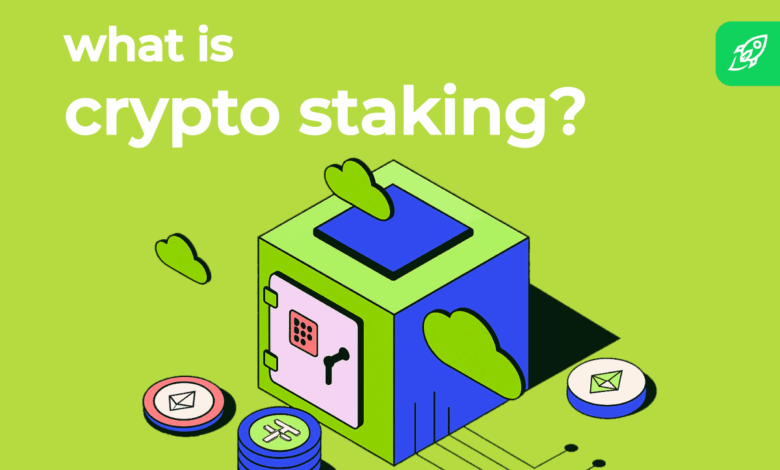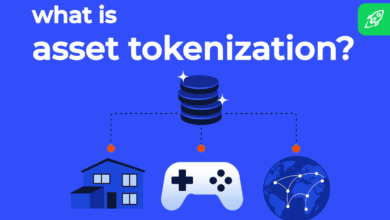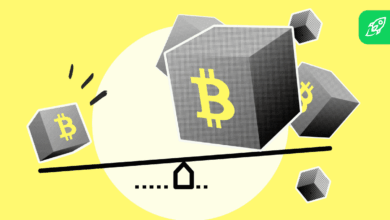What Is Crypto Staking? How to Earn Crypto by Holding It

If you’re holding crypto, why let it sit idle? Crypto staking lets you earn rewards by helping secure blockchain protocols—no mining rigs, no deep DeFi knowledge needed. Whether you’re a long-term investor or a newbie crypto user, staking gives you a direct role in keeping blockchain networks running smoothly while earning passive income in return.
In this guide, you’ll learn what crypto staking is, how staking cryptocurrency works, and what risks to watch out for.
Please remember that this article does not constitute investment advice.
What Is Staking?
Staking is a way to earn rewards that includes a process where users lock their coins or tokens in a wallet to support the operations of a blockchain network that runs on a proof-of-stake (PoS) consensus mechanism. By staking, users temporarily commit their assets to help validate transactions and secure the network, and in return, they earn rewards—usually in the same cryptocurrency—without actually spending their funds.
Instead of using massive amounts of electricity to secure the network like proof-of-work (PoW) systems such as Bitcoin, PoS blockchains rely on users like you to hold and commit coins to help keep the network running.
Read more: PoS vs PoW.
Think of staking like placing a security deposit. You’re helping run a system, and in exchange, you get regular payments. If you act honestly, you earn rewards. If someone tries to cheat the system, though, they risk losing part of their deposit. This helps the network stay fair and secure.
Staking is only available for cryptocurrencies that use proof-of-stake consensus or a variation of it. Ethereum (after its 2022 upgrade), Cardano, and Solana are some of the major coins that support staking.
Why Stake? Staking Benefits for Crypto Investors and Users
Staking offers more than just a way to hold crypto. It gives you practical benefits that go beyond price speculation. For everyday users, staking is a way to earn, contribute, and participate in crypto without the complexity of mining or trading.
1. Earn rewards and passive income
By staking, you receive regular payouts in the same cryptocurrency. This creates a steady stream of passive income. Annual returns range from 4% to over 15%, depending on the network and method. The longer you stake, the more you can potentially earn.
2. Lower energy use (eco-friendly)
Staking supports blockchain networks without the massive energy demand of mining. For example, Ethereum’s switch to proof-of-stake reduced its energy use by over 99.95%. If you’re looking for a greener way to be involved in crypto, staking is it.
3. Help decentralize and secure the network
Your stake increases the network’s overall security. The more users participate, the harder it becomes for any single party to manipulate transactions. This helps keep the blockchain fair, reliable, and censorship-resistant.
4. No need for expensive hardware (unlike mining)
You don’t need to buy mining rigs, pay high electricity bills, or manage noisy equipment. Staking can be done on a basic device or through an exchange, making it far more accessible.
How Does Crypto Staking Work?
Staking is the process of locking your cryptocurrency to support a blockchain network. In return, you earn rewards—usually paid in the same coin you staked.
When you stake, your coins don’t leave your wallet (unless you use an exchange or staking pool). Instead, they are marked as staked assets. These coins are used by the network to decide who gets to confirm new transactions. This is called validating.
Here’s a simple example: imagine 100 people staking a coin. Each person has a different amount of staked coins. The network randomly picks one person to validate a new block. The more coins someone has staked, the more likely they are to be chosen. But it’s not only about quantity—networks also add some randomness to keep things fair.
If you’re chosen as a validator (either directly or through a staking pool), the network rewards you. That’s your staking reward. The reward is usually a small percentage of the total block value or a fixed annual return.
This is how it works in practice:
- You choose a coin that supports cryptocurrency staking.
- You decide where to stake—using a wallet, an exchange, or a staking pool.
- You lock your coins for a staking period (this could be flexible or fixed).
- Your coins help the network validate transactions.
- You receive regular payouts while your coins are staked.
Your coins remain yours but can’t always be moved instantly. Many networks apply an unbonding period—often 7 to 28 days—before staked assets become fully withdrawable.

This system keeps the network secure. If a validator cheats, they lose part of their stake. If they follow the rules, they earn rewards. It’s an efficient way to support the crypto ecosystem without mining.
Types of Staking
There are several ways to stake your crypto assets, each with different levels of control, reward potential, and ease of use. All of them contribute to network security and help validate transactions.
Delegated Staking
You delegate your staked cryptocurrency to a validator instead of running your own node. The validator does the technical work, and you share the rewards. This method is popular on networks like Cardano and Cosmos. It’s low-effort but still gives token holders a role in the staking process.
Exchange Staking
Centralized platforms like Binance or Kraken let you stake directly from your account, and manage everything for you. You just deposit staked tokens and earn rewards. It’s easy to start, but you give up some control since the exchange holds your crypto.
Pool Staking
Pool staking lets you combine your crypto with other users to increase your chances of earning rewards. Instead of staking alone or setting up your own validator, you join a shared pool run by someone else—usually a validator operator. You don’t need a large amount of crypto or technical skills. The pool handles the hard part: validating blocks and maintaining uptime. You receive a share of the rewards based on your contribution, minus a small fee for the operator.
Liquid Staking
You stake your coins and get a token that represents your staked cryptocurrency (like stETH for Ethereum). This token can be traded or used in DeFi while your original assets are still earning rewards. It offers flexibility, but the risks depend on the platform’s reliability.
Solo Staking
You run your own validator node and use your own staked tokens to secure the network. This method gives you full control and the highest share of the staking rewards, but it requires technical setup and a minimum amount of crypto.
Stay Safe in the Crypto World
Learn how to spot scams and protect your crypto with our free checklist.

Cryptocurrency Staking Risks and Considerations
As with anything else that has potentially high rewards, cryptocurrency staking isn’t risk-free. Before you lock up your crypto assets, you should understand the possible downsides tied to the staking process, your chosen staking method, and the network’s consensus mechanism.
- Market risk. The value of your staked coins can drop while locked, reducing overall returns.
- Lock-up periods. Some networks restrict access to your crypto for days or weeks.
- Slashing penalties. Validators who break rules or go offline may lose part of their stake—and so can delegators.
- Validator risk. Choosing an unreliable validator can hurt your rewards or result in penalties.
- Platform risk. With exchange or liquid staking, you’re trusting a third party to manage your crypto assets.
- Changing rewards. Staking returns can vary based on network conditions or inflation.
- Technical complexity. Some staking strategies (like solo staking) require setup, maintenance, and constant monitoring.
- Consensus changes. Networks can change their consensus mechanism, impacting staking terms or ending support.
- Scams and fake platforms. Fraudulent sites may trick crypto holders into sending funds to fake staking programs.
How to Start Staking: A Step-by-Step Guide
You don’t need advanced skills to start staking crypto and getting rewards.

1. Pick a coin
Choose a cryptocurrency that supports staking, like Ethereum, Cardano, or Solana. Check the minimum requirements, expected rewards, and lock-up rules.
2. Choose how you want to stake
Decide between solo staking, delegated staking, exchange staking, or liquid staking. Each method balances control, ease, and risk differently.
3. Create a wallet or sign up to an exchange
Download a wallet that supports staking your chosen coin (e.g. Keplr for Cosmos, Yoroi for Cardano) or create an account, complete verification, and enable 2FA if you’re using an exchange.
4. Buy or transfer the crypto you want to stake
Purchase the coin on an exchange or move it from another wallet. Make sure the amount meets any minimum staking thresholds.
5. Start staking: lock, delegate, or deposit
Depending on your preferred method, you’ll either lock your coins, delegate them to a validator, or deposit them into a staking product.
6. Monitor rewards and understand payouts
Track your rewards, payout frequency, and any changes to the staking process. Some networks pay daily; others weekly or monthly.
Top Cryptocurrencies for Staking
SOL, ETH, ADA, and the other coins below are some of the best assets for cryptocurrency staking. Stablecoins are another popular option for staked cryptocurrency but they generally offer smaller rewards.
Please note that all values in this article are approximate and may change with time. Always DYOR before making any financial decisions.
Ethereum (ETH)
Ethereum’s Pectra upgrade has enhanced staking flexibility, raising the validator cap from 32 to 2,048 ETH. The rewards for ETH crypto staking vary by platform, with solo staking yielding around 3.72% APR. As a top 2 cryptocurrency, Ethereum has a stable market cap and is one of the most reliable options for staking crypto.
Cardano (ADA)
Cardano has a robust staking ecosystem, with approximately 60% of circulating ADA actively staked. Staking rewards range from 2% to 6% APR. The network’s design allows for flexible staking without lock-up periods, making it accessible for a broad range of users.
Solana (SOL)
Solana offers rewards between 5% and 8% annually, influenced by validator performance and network conditions. Staking rewards are distributed every epoch, approximately every two to three days. With over 400 billion transactions processed, Solana’s high throughput makes it a popular choice for stakers.
Polkadot (DOT)
Polkadot’s staking rewards range from 10% to 16% APY. The network employs a Nominated Proof-of-Stake (NPoS) system, allowing users to nominate validators and earn rewards. Unstaking requires a 28-day unbonding period, during which staked DOT remains locked.
Avalanche (AVAX)
Avalanche offers staking rewards between 4.47% and 7.33% APY, depending on the staking method and platform. Delegating AVAX requires a minimum of 25 tokens, while running a validator node takes at least 2,000 AVAX. The network’s staking ratio stands at approximately 50.32%, with over 212 million AVAX staked.
Tezos (XTZ)
Tezos’ recent Rio protocol upgrade has improved staking flexibility, reducing cycle times from three days to one, and allocating 10% of rewards to Layer 2 adoption. Staking rewards range from 3% to 12% APR, with no minimum amount required for delegation. Staked XTZ remains in the user’s account, becoming spendable again after a short delay, upon unstaking.
Cosmos (ATOM)
Cosmos offers some of the highest staking rewards, ranging from 7% to 21% APY, depending on the validator and platform. As of May 2025, approximately 231.8 million ATOM are staked, representing a staking market cap of $1.0 billion. Staking ATOM also provides eligibility for various airdrops within the Cosmos ecosystem.
How Much Can You Earn from Staking?
Typical annual returns range from 3% to 21%. For example, staking Ethereum on a decentralized platform might earn you around 3.7% per year, while staking Cosmos (ATOM) could bring you up to 21%, depending on the validator and platform.
Rewards are paid in the same coin you stake. If you stake 1,000 ATOM at 15% APY, you could earn 150 ATOM per year—before taxes and market fluctuations. You start earning once you begin staking, but check for cooldown or lock-up periods. Some coins require up to 28 days before you can unstake or withdraw.
When calculating the potential rewards you can get from your digital assets, don’t forget to factor in the staking platform’s or, if that’s your preference, your staking wallet’s fees.
Staking vs. Other Crypto Earning Methods
Staking stands out for its simplicity, energy efficiency, and relatively low risk. You earn passive income by helping secure a proof-of-stake blockchain. There’s no need to manage complex DeFi strategies or lend assets to unknown borrowers.
Yield farming requires actively moving your crypto across decentralized protocols to chase the highest returns. It’s time-consuming and often risky, exposing you to smart contract failures, volatile assets, and sudden protocol changes. Lending platforms offer a more stable experience, letting you earn interest on your crypto. But lending relies on borrower trust and platform reliability—both of which have failed in past cycles (see: Celsius, BlockFi).
Staking gives you a middle ground: it’s more stable than farming and less trust-dependent than lending. You’re not trying to beat the market—you’re contributing to it. Here’s how staking compares to these two popular methods:
| Feature | Staking | Yield Farming | Lending |
| Capital Use | Lock crypto in PoS network | Provide liquidity to DeFi pools | Loan crypto to earn interest |
| Typical Return (APY) | 4–21% | 10–300% (high-risk) | 2–10% |
| Risk Level | Medium (validator, slashing, market) | High (rug pulls, impermanent loss, exploits) | Medium (platform or borrower default) |
| Control Over Funds | Partial (locked or delegated) | High (but exposed to smart contract risk) | Medium (depends on custody model) |
| Ease of Use | High (wallets, exchanges, pools) | Low to medium (requires constant management) | Medium (requires trust in third parties) |
| Technical Skill Required | Low to moderate | High | Low to moderate |
| Environmental Impact | Low | Low | Low |
Tips for Safe and Smart Staking
Protecting your staked assets is just as important as choosing how to earn from them. Whether you’re going for custodial staking through an exchange or managing your own validator node, following these tips will help you stake in a safer way while still generating rewards and contributing staking power to verify transactions.
- Start small and learn
Begin with a small amount of crypto. This limits your exposure while you learn how crypto staking works. Once you’re comfortable with staking cycles, unbonding rules, and reward structures, you can increase your position. - Use well-known and trusted platforms
Choose platforms with a track record of reliability, especially for their staking services. Reputable wallets, major exchanges, or official protocol partners reduce the risk of fraud or technical failure. - Research before delegating
If you delegate your stake to a validator, study their performance and uptime. A poorly performing validator reduces your rewards. Some networks also penalize bad behavior, which can affect your staked assets. - Keep your wallet secure
Use hardware wallets when possible. Enable two-factor authentication on exchanges. If someone accesses your wallet, they could redirect your staking rewards or take control of your funds. - Understand when and how to unstake
Every network handles unstaking differently. Some have cooldown or unbonding periods—often between 7 and 28 days—during which you can’t move your coins. Plan ahead, especially during volatile market conditions. If you’re using custodial staking, check if the platform has additional delays or fees.
Final Thoughts: Is Staking Right for You?
Crypto staking is one of the simplest ways to put your assets to work. You don’t just hold tokens—you help validate transactions, support network security, and earn consistent returns along the way. For most token holders, especially those using pool staking or trusted exchanges, it’s a low-barrier entry into active participation. Just make sure you understand the transaction fees, platform risks, and lock-up conditions before you commit.
FAQ
Can all cryptocurrencies be staked?
No, only cryptocurrencies built on proof-of-stake (PoS) or similar consensus models can be staked. You can’t stake Bitcoin or other proof-of-work coins.
Is staking crypto worth it?
Yes, staking is worth it if you’re looking to grow your digital assets without selling them. You can earn between 3% and 21% annually, depending on the coin, platform, and minimum staking requirements. It’s a good alternative to a savings account, especially if you believe in the long-term value of your chosen cryptocurrency.
Can I lose money staking crypto?
Yes, you can lose money. If the price of your staked cryptocurrency drops during the lock-up period, your staked capital loses value. There are also security risks, like validator penalties (slashing), unreliable staking platforms, and scams. Always DYOR before choosing where and how to stake.
Does your crypto still grow while staking?
Yes, it grows. While your crypto transactions are locked, you earn regular payouts in the same cryptocurrency.
Is staking crypto legal?
Yes, staking crypto is legal in most countries. But local laws vary, especially regarding taxes and financial reporting. Always check your local regulations if you’re staking large amounts or using crypto exchanges that operate internationally.
Is crypto staking taxable?
Yes, in most jurisdictions, rewards earned from staking cryptocurrency are considered taxable income. Some countries also tax capital gains when you sell your rewards. Always report your earnings and consult a tax advisor if needed.
Can I still access my crypto while it’s staked?
No, not instantly. While your crypto wallet still shows ownership, your staked coins are locked. Some platforms offer liquid staking, which gives you a tradeable token representing your staked crypto. But otherwise, you’ll need to wait for an unbonding period, usually 7 to 28 days, before you can move your funds.
What happens if the price of my crypto drops while it’s staked?
If your digital assets lose value while staked, your total returns can shrink or turn negative. You’ll still earn staking rewards, but the drop in price can cancel them out. This is why market volatility is one of the key security risks to consider before staking in the crypto world.
Disclaimer: Please note that the contents of this article are not financial or investing advice. The information provided in this article is the author’s opinion only and should not be considered as offering trading or investing recommendations. We do not make any warranties about the completeness, reliability and accuracy of this information. The cryptocurrency market suffers from high volatility and occasional arbitrary movements. Any investor, trader, or regular crypto users should research multiple viewpoints and be familiar with all local regulations before committing to an investment.





